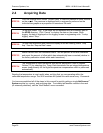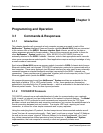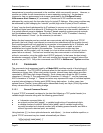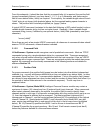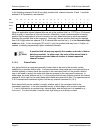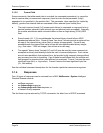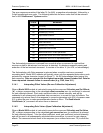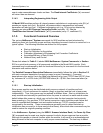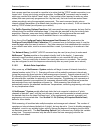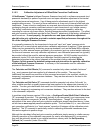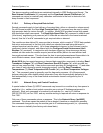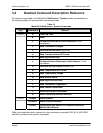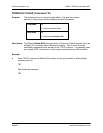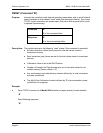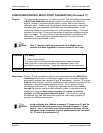
Pressure Systems, Inc. 98RK-1 & 9816 User’s Manual©
Page 37 www.PressureSystems.com
that a power reset has occurred in a module is to notice that the TCP/IP socket connection is no
longer valid. At any point during module operation, the Reset ('B') command may be used to
return any module to its default “reset” state. If the module is then required to enter any other
states (that were previously programmed for it by the host), the host must then restore these
states accordingly using the appropriate commands. This reset command simply returns
internal software parameters to a default state (as after power up or reboot). It will not close the
existing TCP/IP socket (as will power up or reboot).
The Set/Do Operating Options/Functions ('w') command has many purposes, but may first be
utilized during the module initialization stage. It may also be executed at any time during data
acquisition. However, some non-factory-default options of 'w' may become the new reset
default, if a particular function is used to establish them in non-volatile memory.
If any form of the Configure/Control Autonomous Host Streams ('c') command or the
Configure/Control Multi-Point Calibration ('C') command was in use before reset, it must be
executed again after the reset to restore it. Any other command, that establishes the module in
a non-default reset state, must be re-executed after a reset, if processing is to continue in that
state.
The Network Query (“psi9000”) UDP/IP command may be used (at any time) to make each
NetScanner
™
System module on the network identify itself to the host(s). A parameter,
returned in each module’s response, indicates whether or not a module still has a valid
connection. This is a useful way to detect if an overt reset occurs in a module. The module
may be configured to emit this response automatically after any reset (power on or reboot).
3.1.5.2 Module Data Acquisition
After power-up, all NetScanner
™
System modules will begin to scan all internal channels in
channel number order (16 to 1). Scanning will occur at the module's maximum internal rate
(using the previously stored number of data averages per channel). Special external rack (P &
S) channels of the 9816 module are also scanned, but less frequently. The data are stored in
an internal buffer, available for retrieval by the host computer. Engineering units conversion of
the scanned channels is accomplished (in a separate internal buffer) using thermal correction
data extracted from each transducer at power-up. While scanning, the module will
automatically monitor the attached transducers’ temperatures, correcting engineering unit output
for any temperature effects.
All NetScanner
™
System models effectively defer the host computer’s decision of “which
channels of data do I want” until the host chooses to send read commands to actually retrieve
the desired data from the latest “buffered copy” of the continuously scanned, averaged, and
engineering-unit-converted data. See Section 3.1.5.4 (Delivery of Acquired Data to Host)
below for more details.
While scanning, all modules take multiple samples and average each channel. The number of
samples per internal channel defaults to 8 (eight), but may be set to 1 (one) to disable averaging
altogether, or set to any suitable higher value to change the degree of averaging (and its effect
on maximum scan rate). The Set Operating Options ('w') command may change this variable
at any time. The same command may be used to store the new averaging value as the
module’s reset default.



